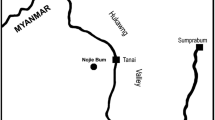Abstract
OneCycadeoidea stem one cycadeoidalean gynoecium and a bisporangiate cone attached to a slender cycadeoidalean trunkCycadeoidella japonica Ogura from the Cretaceous of Japan shows well-preserved internal structure that provides evidence for a better understanding of the morphological architecture of the cycadeoidalean plant. Structural details of the cone were confirmed. The ovule has an intergument enclosing a free nucellus and a thin outer envelope. Both reproductive and vegetative structures support the medullosan affinity of Cycadeoidales. The cone is interpreted as a compressed fertile shoot. Axillary cones characterizing some Cretaceous genera such asCycadeoidea andMonanthesia consist of a lateral shoot subtended by a frond that is the first leaf of the cone shoot itself. The origin of axillary buds in the Cycadeoidales is discussed. Heterochrony may have mediated the morphological changes that resulted in the establishment of the Cycadeoidales.
Similar content being viewed by others
References
Andrews, H.N. 1961. Studies in Paleobotany. John Wiley & Sons, New York.
Crane, P.R. 1986. Phylogenetic analysis of seed plants and the origin of Angiosperms. Ann. Missouri Bot. Gard.72: 716–793.
Crane, P.R. 1986. The morphology and relationships of the Bennettitales.In R.A. Spicer and B.S. Thomas eds., Systematic, and Taxonomic Approaches in Palaeobotany. Oxford Univ. Press, Oxford, pp. 163–175.
Crepet, W.L. 1974. Investigations of North American cycadeoids: The reproductive biology ofCycadeoidea. Palaeontographica B148: 144–169.
Crepet, W.L. andDelevoryas, T. 1972. Investigations of North American cycadeoids: Early ovule ontogeny. Amer. J. Bot.59: 209–215.
Cutter, E.G. 1971. Plant Anatomy: Experiment and Interpretation. Part 2. Organs. Edward Arnold, London.
Delevoryas T. 1959. Investigations of North American cycadeoids:Monanthesia. Amer. J. Bot.46: 657–666.
Delevoryas, T. 1960. Investigations of North American cycadeoids: trunks from Wyoming. Amer. J. Bot.47: 778–786.
Delevoryas, T. 1968a. Investigations of North American cycadeoids: structure, ontogeny and phylogenetic considerations of cones ofCycadeoidea. Palaeontographica B121: 122–133.
Delevoryas, T. 1986b. Some aspects of Cycadeoid evolution. J. Linn. Soc. (Bot.)61: 137–146.
Dennis, R.L. andEggert, D.A., 1978.Parasporotheca, gen. nov. and its bearing on the interpretation of the morphology of permineralized medullosan pollen organs. Bot. Gaz.139: 117–139.
Doyle, D. andDonoghue, M.J. 1986. Seed plant phylogeny and the origin of angiosperms: An experimental cladistic approach. Bot. Rev.52: 321–431.
Esau, K. 1977. Anatomy of Seed Plants. 2nd Ed. John Wiley & Sons, New York.
Gould, S.J. 1977. Ontogeny and Phylogeny. Harvard Univ. Press, Cambridge.
Joy, K.W., Willis, A.J. andLacey, W.S. 1956. A rapid cellulose peel technique in palaeobotany. Ann. Bot.20: 635–637.
Nishida, H. 1991. Diversity and significance of Late Cretaceous permineralized plant remains from Hokkaido, Japan. Bot. Mag. Tokyo104: 253–273.
Ogura, Y. 1930. On the structure and affinities of some Cretaceous plants from Hokkaido. J. Fac. Sci. Imp. Univ. Tokyo, Sect 3,2: 381–412.
Rothwell, G.W. 1986. Classifying the earliest gymnosperms.In R.A. Spicer and B.A. Thomas eds., Systematic and Taxonomic Approaches in Palaeobotany. Oxford Univ. Press. Oxford, pp. 137–161.
Rothwell, G.W. 1987. The role of development in plant phylogeny: a paleobotanical perspective. Rev. Palaeobot. Palynol.50: 97–114.
Sahni, B. 1932. A petrifiedWilliamsonia (W. sewardiana, sp. nov.) from the Rajmahal Hills, India. Palaeontologica Indica (N.S.)20: 1–19.
Sharma, B.D. 1970. On the vascular organization of the receptacles of seed-bearing Williamsonias from the Middle Jurassic Rocks of Amarjola in the Rajmahal Hills, India. Ann. Bot.34: 1971–1978.
Stewart, W.N. 1976. Polystely, primary xylem, and the Pteropsida. Birbal Sahni Inst. Palaeobot. Lucknow, pp. 1–13.
Stewart, W.N. andRothwell, G.W. 1993. Paleobotany and the Evolution of Plants. Cambridge Univ. Press, Cambridge.
Stidd, B.M. 1981. The current status of medullosan seed ferns. Rev. Palaeobot. Palynol.32: 63–101.
Taylor, T.N. andTaylor, E.L. 1993. The Biology and Evolution of Fossil Plants. Prentice Hall, Englewood Cliffs, New Jersey.
Wieland, G.R. 1906. American Fossil Cycads. Carnegie Institution of Washington (Publ. 34), Washington, D.C.
Author information
Authors and Affiliations
Rights and permissions
About this article
Cite this article
Nishida, H. Morphology and the evolution of cycadeoidales. J. Plant Res. 107, 479–492 (1994). https://doi.org/10.1007/BF02344069
Received:
Accepted:
Issue Date:
DOI: https://doi.org/10.1007/BF02344069




